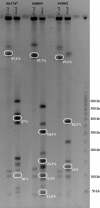Genomic diversity in Staphylococcus xylosus
- PMID: 17890333
- PMCID: PMC2168225
- DOI: 10.1128/AEM.01629-07
Genomic diversity in Staphylococcus xylosus
Abstract
Staphylococcus xylosus is a commensal of the skin of humans and animals and a ubiquitous bacterium naturally present in food. It is one of the major starter cultures used for meat fermentation, but a few strains could potentially be hazardous and are related to animal opportunistic infections. To better understand the genetic diversity of S. xylosus intraspecies, suppressive and subtractive hybridization (SSH) was carried out with the S. xylosus C2a strain, a commensal of human skin, used as the driver for three tester strains, S04002 used as a starter culture, S04009 isolated from cow mastitis, and 00-1747, responsible for mouse dermatitis. SSH revealed 122 tester-specific fragments corresponding to 149 open reading frames (ORFs). A large proportion of these ORFs resembled genes involved in specific metabolisms. Analysis of the distribution of the tester-specific fragments in 20 S. xylosus strains of various origins showed that the S. xylosus species could be divided into two clusters with one composed only of potentially hazardous strains. The genetic content diversity of this species is colocalized in a region near the origin of replication of the chromosome. This region of speciation previously observed in the Staphylococcus genus corresponded in S. xylosus species to a strain-specific region potentially implicated in ecological fitness.
Figures



References
-
- Cartron, M. L., S. Maddocks, P. Gillingham, C. J. Craven, and S. C. Andrews. 2006. Feo transport of ferrous iron into bacteria. Biometals 19:143-157. - PubMed
-
- Diab, F., T. Bernard, A. Bazire, D. Haras, C. Blanco, and M. Jebbar. 2006. Succinate-mediated catabolite repression control on the production of glycine betaine catabolic enzymes in Pseudomonas aeruginosa PAO1 under low and elevated salinities. Microbiology 152:1395-1406. - PubMed
-
- Dordet-Frisoni, E., R. Talon, and S. Leroy. 2007. Physical and genetic map of the Staphylococcus xylosus C2a chromosome. FEMS Microbiol. Lett. 266:184-193. - PubMed
Publication types
MeSH terms
Substances
Associated data
- Actions
- Actions
- Actions
- Actions
- Actions
- Actions
- Actions
- Actions
- Actions
- Actions
- Actions
- Actions
- Actions
- Actions
- Actions
- Actions
- Actions
- Actions
- Actions
- Actions
- Actions
- Actions
- Actions
- Actions
- Actions
- Actions
- Actions
- Actions
- Actions
- Actions
- Actions
- Actions
- Actions
- Actions
- Actions
- Actions
- Actions
- Actions
- Actions
- Actions
- Actions
- Actions
- Actions
- Actions
- Actions
- Actions
- Actions
- Actions
- Actions
- Actions
- Actions
- Actions
- Actions
- Actions
- Actions
- Actions
- Actions
- Actions
- Actions
- Actions
- Actions
- Actions
- Actions
- Actions
- Actions
- Actions
- Actions
- Actions
- Actions
- Actions
- Actions
- Actions
- Actions
- Actions
- Actions
- Actions
- Actions
- Actions
- Actions
- Actions
- Actions
- Actions
- Actions
- Actions
- Actions
- Actions
- Actions
- Actions
- Actions
- Actions
- Actions
- Actions
- Actions
- Actions
- Actions
- Actions
- Actions
- Actions
- Actions
- Actions
- Actions
- Actions
- Actions
- Actions
- Actions
- Actions
- Actions
- Actions
- Actions
- Actions
- Actions
- Actions
- Actions
- Actions
- Actions
- Actions
- Actions
- Actions
- Actions
- Actions
- Actions
- Actions
LinkOut - more resources
Full Text Sources
Molecular Biology Databases

